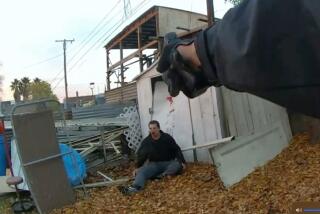Stephon Clark was shot six times in the back by police, independent autopsy finds
Reporting from SACRAMENTO — Stephon Clark, the unarmed African American man whose shooting by police sparked protests and national outcry, was shot six times in the back, an independent forensic pathologist said Friday.
Dr. Bennet Omalu conducted an autopsy days after Clark was killed by police. He told reporters that his examination showed that Clark was hit by eight bullets, and all but one entered while his back was turned toward the two officers.
One bullet entered Clark’s left thigh from the front and was probably fired while he was on the ground and had already been shot multiple times, Omalu said.
The independent autopsy finding raises new questions about Clark’s shooting, which is now the subject of investigations by both local and state officials. The county coroner’s official autopsy results are not expected to be completed for several weeks.
Clark, 22, was fatally shot in his grandmother’s backyard on March 18 by Sacramento police, who were looking for a vandal in the neighborhood. More than 20 shots were fired. Clark was found with a cellphone. No weapon was recovered.
Police have released videos showing the incident but have urged the public not to pass judgment on officers until the investigation is complete.
Clark’s supporters say the family’s autopsy contradicts police accounts of what happened.
“It’s very simple. The narrative that’s been put forth is they had to open fire because he was charging toward them,” said civil rights litigator Ben Crump, who is representing Clark’s family. Yet the autopsy shows, Crump said, “all of the bullets were from behind.”
A “cluster” of bullets that entered Clark’s back destroyed his body, each carrying “fatal capacity,” Omalu said.
One round fractured Clark’s right arm, shattering a section of bone into bits that lacerated all the blood vessels around the wound, he said, and another cut through Clark’s flesh and hit his spinal cord, where it caused massive bleeding.
A round went under Clark’s rib, piercing his lung, and caused massive bleeding in his chest, Omalu said. Another injured his aorta.
The combination of trauma, bleeding and a punctured lung would have cut off oxygen to Clark’s brain, but he did not die instantly, Omalu said. It took several minutes, he said.
Omalu was brought in by lawyers for Clark’s family in preparation for a planned federal lawsuit against the city and its police officers. He resigned last year as chief forensic pathologist in neighboring San Joaquin County, citing allegations the sheriff there sought to sway findings to protect officers responsible for fatal shootings. Others in Omalu’s office also quit, but the sheriff denied the allegations.
Sacramento authorities did not immediately comment on the autopsy results.
Outside law enforcement experts have differed about whether the officers acted properly, based on what is currently known. But one said Friday that the fact that Clark was shot in the back does not necessarily mean the officers were in the wrong.
Ed Obayashi, a Plumas County sheriff’s deputy and a legal advisor to the department, said he believes the officers’ decision to shoot was reasonable under the circumstances, especially since they believed the object in Clark’s hands was a weapon and one of the officers had yelled, “Gun, gun.”
“The shots in the back. They don’t change my opinion at all,” he said. “This is a situation of two to two and half seconds with multiple rounds being fired here, and that time passes very fast. The human brain — the mind in these situations — cannot process quick enough to stop firing.”
The shooting sparked days of protests in the state capital and made national headlines. Another march is called for Saturday, to be led by retired NBA player Matt Barnes, a Sacramento native who once played for the Sacramento Kings and the Lakers.
Clark was buried after a funeral in Sacramento on Thursday attended by hundreds of mourners, including the Rev. Al Sharpton.
Sacramento’s mayor has called Clark’s death “wrong,” but said he cannot pass judgment on the officers’ actions until the investigation is complete.
On Wednesday, a police spokesman said Clark remained the sole suspect in break-ins of vehicles and what a sheriff’s deputy said was the attempted break-in of a home. It was a call about those incidents that sent police to the neighborhood the night Clark was shot.
A Sacramento County Sheriff’s Department helicopter spotted a man in a backyard and directed police toward him, authorities said. Deputies told officers that the man had picked up a “toolbar” and broken the window of a home.
The man was seen running south, toward the front of the house, where he stopped and looked into another car, police said. Police body camera footage shows that officers intercepted Clark in the backyard of his grandmother’s house, and one of them yelled “gun!” as he turned a corner and saw Clark. The officer ducked back momentarily, then looked around the corner again and, shouting “gun! gun! gun!” began rapid fire. His partner then joined in the shooting.
The officers told other police who arrived on the scene they thought Clark was pointing something at them. “It looked like a gun from our perspective.”
The object found when they rolled over Clark’s bleeding body was a white cellphone.
Clark was pronounced dead at the scene. Police video shows that several minutes passed until officers approached Clark’s body. They then handcuffed him before appearing to attempt resuscitation.
Omalu said Friday that it would have taken from three to 10 minutes for such wounds to kill Clark. “Every minute you wait decreases the probability of survival,” he said.
Clark’s family has denied he had anything do with any break-ins. His grandmother said she heard gunfire in her backyard and asked her husband to call police. But police were already there, having just fatally shot Clark.
“Why didn’t you shoot him in the arm? Shoot him in the legs? Send in dogs? Send in a Taser? Why? Why?” grandmother Sequita Thompson said.
Sacramento police have refused to name the two officers who shot Clark, but they were identified by an area civil rights attorney who saw their names on unedited video captured by the body cameras they wore.
One of the officers, who is African American, grew up in the Sacramento Valley and joined the department in 2016 after prior work with a police department in Mississippi. Video shows he stepped in beside his partner to shoot at Clark after the gunfire had started.
According to the videos, the first to fire was a white officer who state police records show has been with the city department since 2014.
There is no indication of either officer being named in state or federal litigation alleging police misconduct while in Sacramento, court dockets show.
It is common in police shooting cases, after one officer opens fire, for his or her partner to also begin shooting without seeing the threat, said John Burris, an Oakland-based lawyer whose firm has assisted in gathering evidence for the Clark case. “The other just shoots in response,” Burris said.
Seth Stoughton, a University of South Carolina law professor and former Tallahassee, Fla., police officer who studies police shootings, said that “watching the helicopter video, it seems the officers are shooting after [Clark] is down on the ground.” Stoughton said the shots in the back suggest that the young man was likely down or had fallen to the ground when officers continued to fire.
But “just because someone is on the ground, it does not mean they are not a threat,” he said. “The big question here is, ‘Was the shooting justified at all?’ And I don’t think the videos provide a clear answer one way or another.”
The officers’ turning off the audio recording of the shooting is also problematic, Stoughton said. He said that officers mute audio either to corroborate their stories or because they felt they needed a moment of privacy after such a traumatic event.
“Just because we can understand why an officer turned off their recording, it doesn’t make it OK,” he said.
Stoughton said the videos show officers confront Clark, seemingly duck back for cover and then confront him again.
“The question is how well did officers see Mr. Clark? Another question is whether officers who had some cover could have maintained their position of relative safety until they could assess the situation.”
Retired Los Angeles County Sheriff’s Cmdr. Charles “Sid” Heal also said the autopsy findings need to be looked at in a larger context.
“I am not surprised he was shot in the back...he may have turned and ran,” Heal said, adding that the officers’ deadly shooting is “just not pretty.”
In this case, he said, “the officers made their decision based on circumstances. ‘Is that reasonable?’ is the question. Once you are convinced the suspect has a weapon, you go into response mode. Self-preservation takes over. We try to train that out of people.”
St. John reported from Sacramento, and Serna and Winton from Los Angeles.
UPDATES:
5:10 p.m.: Updated with minor edits.
3 p.m.: This article was updated with more comment from experts.
2:25 p.m.: This article was updated with comments from legal experts.
1:45 p.m.: This article was updated with information about the officers involved in the shooting.
12:40 p.m.: This article was updated with additional details from the independent autopsy.
11:40 a.m.: This article was updated with additional comments from Dr. Bennet Omalu.
11:25 a.m.: This article was updated with findings from an independent autopsy of Stephon Clark.
This article was originally published at 10 a.m.
More to Read
Sign up for Essential California
The most important California stories and recommendations in your inbox every morning.
You may occasionally receive promotional content from the Los Angeles Times.











